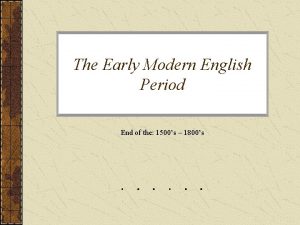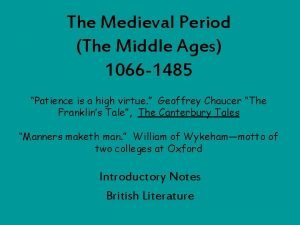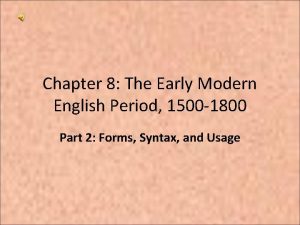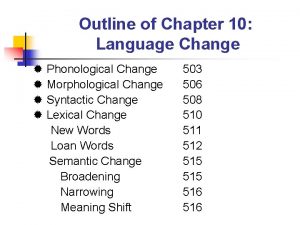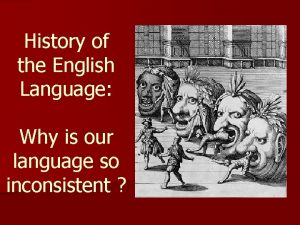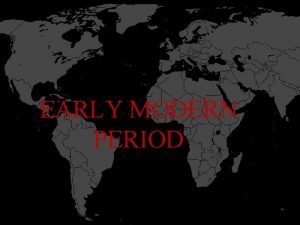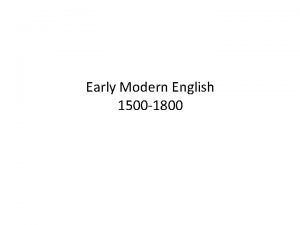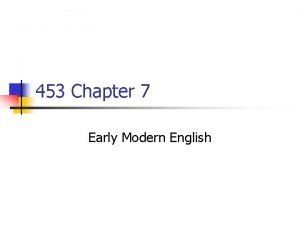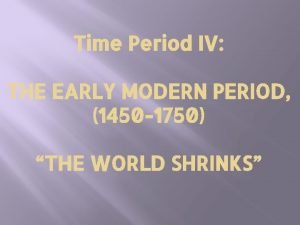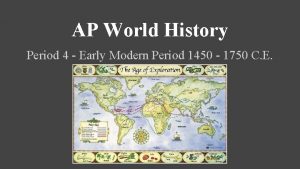Chapter 8 The Early Modern English Period 1500













- Slides: 13

Chapter 8: The Early Modern English Period, 1500 -1800 Part 2: Forms, Syntax, and Usage

Backup Copy: http: //faculty. winthrop. edu/koster j/engl 507/lectures/Chapter 8 B. ppt

Grammatical Changes • All plurals for new words are regular (-s or –es) • A few irregular plurals survive • The his-genitive develops to spell out the –s in the genitive singular. By analogy a her-genitive and a their-genitive develop. – Especially seen with proper names and especially after proper names ending in sibilants: “characters as red as Mars his heart; ” “Margery Brewys her mark; ” “the House of Lords their proceedings”

• Group genitive: ‘s is added to the last word in the word group, not to the word it actually inflects [the King of England’s army= the (King + genitive) of England army] – ‘s is an enclitic ending—attached to the closest word, not to the word it morphologically modifies. • Uninflected genitives: Ladychapel, chrissake (the elision and loss of the dental in “christ” leading to the loss of the genitive ‘s before the sibilant in ‘sake’)

Adjectives and Adverbs • Loss of strong/weak distinction but sometimes the survival of a silent –e on the end • Only adjectives that still have to agree in number with the nouns they modify are this/these and that/those • Increased use of analytical forms for comparatives and superlatives (more/most rather than –er/-est); sometimes double comparison exists in EMod. E

Pronouns • Grammatically, the part of speech that changes most in the EMod. E period – I is almost always capitalized – My/mine and thy/thine (with mine/thine being used before vowel SOUNDS) – Loss of second person singular pronouns (thou, thee, thy, thine); second person plural pronouns extend to cover the declension • No distinction like French tu/vous or German Du/Sie • Translators of KJV deliberately retained archaic pronouns thee, thou, thine – Neuter nominative singular loses its initial [h]: now it instead of hit – Second person singular agreement (you was not you were) until the schoolmastering grammarians got hold of it in the late 18 th century

Relative and Interrogative Forms • Who (OE hwā) comes to be the relative referring to humans only in the 16 th century • That (restrictive relative) and which (nonrestrictive relative) appear in almost equal frequencies in speech • The that/which rule comes from Fowler’s English Usage (1905); a late example of schoolmastering

Cases of Pronouns • Example of linguistic anxiety • Attempts to regularize usage in 17 th and 18 th centuries • Hypercorrection often applied (“They invited Mary and me” becomes “They invited Mary and I” • I/me often shaky after forms of the verb “to be” • Who/Whom started worrying people in the late 15 th century—still a great deal of variation

Verbs • Virtually all new verbs borrowed in as weak verbs with 3 principal parts • Strong verbs disappearing or may develop alternate (weak) forms • Confusion over related forms such as lie/lay and sit/set (look these up in the OED)

The Progressive Aspect • Extension of be- forms with present participles: I am working; they are dancing • Largely due to loss of on as a preposition before the participle used as gerund from phonological leveling • Happens in 16 th c. • By 18 th c. has extended to passive voice: The house is being built. Earliest example of this is 1762; makes it into grammar books by 1802, though still being attacked as “careless” usage into late 19 th c.

More about verbs • A few inflectional endings disappear (though the silent –e spelling may be retained) • Second- and third-person singular forms start to collapse • The second person plural of “to be” is very irregular • “Do-support” (‘The lady doth protest too much’) is frequent

Contractions • Don’t is the mystery contraction • Ain’t (for am not—possibly with a scribal variation on minims)—originally may have been a high-class status form • ‘twill’= ‘it will’ gradually replaced with “it’ll” • ‘ve for “have” an 18 th century phenomenon: “He could’ve done it” • Phonological spelling “he would of done it”-an example of eye dialect

Prepositions • Elision and leveling of unstressed prepositions leads to a- forms and some others: “aboard”=on board; “abed” = in bed; “once a day” = once in a day • More fuss about ending sentences with prepositions, which you can’t do in Latin but can do nicely in English —it just drives the prescriptive grammarians crazy. Another example of schoolmastering!
 Early modern english period
Early modern english period Middle english period (1066-1500)
Middle english period (1066-1500) Early modern period dates
Early modern period dates British literature periods
British literature periods Early modern english syntax
Early modern english syntax Early modern english
Early modern english Accent and dialect english language a level revision
Accent and dialect english language a level revision Modern english time period
Modern english time period Tumoxan
Tumoxan Old english vs modern english
Old english vs modern english Old english vs modern english
Old english vs modern english Early cpr and early defibrillation can: *
Early cpr and early defibrillation can: * Early american floral design
Early american floral design Byzantine floral design
Byzantine floral design
